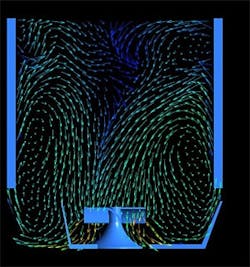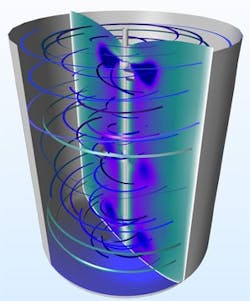The era of mixing simulations requiring experts in computational fluid dynamics (CFD) and sometimes taking weeks to run is long gone. Driven by huge leaps in computing and related technologies, companies such as Ansys, Comsol and Flow Science are bringing easy-to-use mixing simulation to the engineer’s desktop.
“Advances in parallelization and high-performance computing, as well as templatization, have brought accurate CFD simulation into the reach of non-expert chemical engineers,” says Bill Kulp, lead product marketing manager, fluids, Ansys Inc., Pittsburgh, Pa.
Exemplifying this, the company has just begun a project with Nalco Champion, Houston, that will give chemical engineers there — none of whom are experts in simulation — access to Ansys Fluent and a simulation app based on an analysis control technology (ACT) template to quickly and efficiently scale up processes for new chemicals.
“The company has been quite frustrated with failures, especially with new reaction designs that won’t work with their library of tank models, and are looking to CFD simulation to reduce costs and increase the success rate of their scale-ups,” explains Ansys senior account manager Erik Shank.
Figure 1. Velocity vectors for the final impeller design show improved mixing performance with a stronger downflow than achieved with the original. Mixer also uses 12% less electricity. Source: Aditya Birla Science & Technology Co. Pvt. Ltd.
Up to now, Nalco Champion’s workflow typically involved completing hundreds of new reactions, 10–15% of which wind up moving into production test phases. Of these, only a handful eventually go forward, based on reaction yield, availability/cost of feedstock chemicals and other relevant data.
With each scale-up costing around $250,000, Nalco intends to use simulation to improve process costs and efficiency by eliminating at a very early stage the ones that are less likely to succeed.
“Chemical engineers can now focus on reactions and not complex CFD. The overall goal is to automate the process with a user defined field (UDF)/ACT extension to allow them to submit reactions into the simulation for on the fly decision-making,” adds Shank.
Success In India
Kulp points to a 2016 project carried out with Aditya Birla Science & Technology, Navi Mumbai, India, which resulted in an improved impeller for the mixing tank used in viscose staple fiber (VSF) manufacturing.
VSF is produced by dissolving a wood pulp slurry in caustic soda and then forcing the solution through tiny holes in a metal cap. Mixing the slurry and caustic soda solution is both time consuming and expensive in terms of electricity use.
The Ansys team started with a steady-state multiphase simulation of the existing mixer to better understand the turbulent nature of the VSF mixing process. They employed a number of models to do this, including the frozen rotor mixing model for impeller motion and the Euler-Euler inhomogenous multiphase model to simulate the liquid/solid mixing in the system.
This led to an initial impeller design, which then went through six iterations to optimize the tradeoff between mixing performance and power consumption. The final design (Figure 1) uses a curved-blade impeller placed near the bottom of the tank and provides a five-fold improvement in mixing of the solid suspensions together with a 12% cut in electricity consumption.
Faster Decision-Making
CFD technology itself continues to advance, driven by improved computing resources and robust, accurate and scalable numerical methods. Important, too, is the ability to successfully perform multivariate analyses.
“These enable our customers to carry out hundreds of ‘what if?’ types of analyses early in the design phase and quickly assess product performance for strength, power, thermal, pressure, flow rate, electrical or a number of other performance requirements. Through this digital exploration, designers and product engineers can identify optimal combinations while eliminating outlying designs — saving time and money. This multivariate design-of-experiment approach helps them to identify the ‘best’ operating condition rather than one that is simply ‘good enough,’” says Kulp.
This thinking is reflected in the launch of Ansys 18 at the end of January. The latest version of the company’s simulation technology also integrates with Internet of things platforms to ease the use of “digital twins” of assets in operation.
Digital twins are virtual representations of individual operating assets that can be used to improve the performance and productivity of the actual equipment through simulation technology. Sensors on a mixer, for example, relay specific operating data such as temperature, vibration, impact and loading to the digital twin. This continuous feedback helps engineers optimize the operation of the mixer and can predict adverse conditions long before they happen — potentially unlocking massive production and maintenance savings for entire processes and plants.
“The use of digital twins is really exciting because it puts simulation at the heart of product and equipment development. You take simulations of individual components and processes and tie them together to form a complete digital prototype. This can be customized based on specific history of an individual device to predict performance over time — for example, reliability and likely failure modes,” he adds.
Figure 2. Simulation shows that mixing is not good but shear rates are moderate, which is crucial for fermentation application. Source: Comsol.
As simulation is adopted across the entire product lifecycle, engineers are becoming more empowered to imagine more options, a trend Ansys calls pervasive engineering simulation.
This, Kulp believes, is a glimpse of the future: “In 5–10 years Ansys simulation may be embedded with your PID/control software for pervasive predictive control of your mixing processes.”
Similar Story
Comsol, Stockholm, Sweden, is seeing the same thing. “Simulation is becoming much more widely used and understood by the chemical industry,” notes chief technology officer Ed Fontes.
The company has developed a broad portfolio of software modules, including one for mixers that is particularly aimed at the batch, fine chemicals and pharmaceuticals end of the market, and the CFD and chemical reaction engineering modules that are targeted at bulk manufacturers.
As an example of the use of the mixer module, he cites an Argentinean laboratory that was working to take a fermentation process from pilot to commercial scale.
“It’s quite easy to get a uniform mixture here, but if the shear rates are too high you will kill the yeast cells and you will not get any fermentation. So what we look for is an optimum of maximum mixing velocity with the minimum damage caused by shear rate — which is a kind of contradiction. So to achieve this we need to create eddies, a sort of chaotic flow, but with not too violent velocity gradients.”
Once a pilot-scale process worked and a model had been validated for that scale, Comsol used the model to estimate the maximum shear rates; these data then served as the limit for the allowed shear rates in a model of a full-scale process (Figure 2).
“In other words, we can use the model to maximize the mixing for the full-scale process under the condition that the shear rates are below the values that would kill the yeast cells. This type of scale-up problem is very common in the pharma industry, too. Processes that are sensitive to operating conditions can be dealt with in a similar way for scale-up and design,” he adds.
The savings for users come from getting a much better product, plus only needing one pilot plant before going full-scale instead of the 20 or more that are used in some cases.
Comsol stresses that it takes a unique approach for generating the mathematical equations used in CFD and chemical reaction engineering modules. “Everyone in this field produces numerical models that make approximations of the continuous mathematical models by using different types of discretization such as finite difference, finite volume, finite element, etc. We are different in that we generate a full mathematical model with no approximations as a first step. Users can even apply their own mathematical equations via the graphical user interface (GUI) and these are incorporated just as any other ‘native’ equation into the problem. That’s unique to us and it makes the simulation even more efficient for users. It’s also patented,” says Fontes.
Users don’t need programming skills, just the math, he emphasizes, noting that chemical engineers typically already have — or can look up — the mathematical expressions they require. There’s no need for a dedicated software operator to incorporate a company’s own expressions for transport properties, material properties and reaction kinetics into a model.
Continuing Challenges
Simulating multiphase flow still poses challenges. Comsol has adopted a twin approach with its interface tracking and dispersed multiphase flow models.
The challenge with the first is to get an accurate description of the flow, droplet breakup and droplet coalescence (or bubble break up and coalescence) at a decent performance rate. Better performance allows for simulation of more droplets (or more bubbles), which also increases the fidelity of the description of the flow of the whole multiphase mixture.
The findings about interaction between droplets from detailed interface tracking models can be used in dispersed multiphase flow models, where the two phases are modeled as volume fractions rather than as individual droplets or bubbles. The dispersed models thus are approximations of the more-detailed interface tracking models.
“The challenge here is to accurately describe interactions between droplets, droplet breakup and droplet coalescence without having the detailed description of the interface. Dispersed flow models have to be adapted to the nature of the fluids and the conditions of the flow to a higher degree than do interface tracking models; these can be done ab initio, i.e., with a minimum of assumptions and approximations,” notes Fontes.
Another initiative is Application Builder. This allows an R&D department to build an app specifically for use in its own processes or plants. It boasts an intuitive and user-specific interface, and allows process engineers access to a ready-to-use simulation app that is tailored for their needs.
“Some of our customers are using the Application Builder already and finding it a very efficient way of benefiting from simulation,” he adds.
The company also hopes eventually to offer access to large eddy simulation (LES) technology which givesextremely detailed descriptionsof turbulence.
Giving Mixing Its Due
“The chemical industry stands to gain a lot from using computational tools such as CFD, but mixing processes are sometimes overlooked because of their assumed simplicity. However, there are many interesting ways to achieve excellent performance using modern numerical techniques,” notes Ioannis Karampelas, CFD engineer with Flow Science Inc., Santa Fe, N.M.
Many such techniques are included in the company’s Flow-3D Multiphysics modeling software package and its dedicated post-processor visualization tool FlowSight.
“All commercial CFD packages come bundled with some form of visualization tool but FlowSight is designed to be very powerful, simple to use, and easy to understand. For example, an engineer trying to redesign a process needs a very intuitive visualization tool to evaluate the effectiveness of various design changes,” he explains.
This approach works particularly well to better understand and optimize processes where experimental measurements are hard to obtain, i.e., for parameters that are not easily measured and for processes that are inherently dangerous because of the presence of toxic substances, for example.
The same approach also has helped suppliers of mixer-related equipment to more accurately develop and tailor their products to customer demands. “This avoids unnecessary prototyping costs or potential over-engineering. Both have been a problem for some suppliers,” says Karampelas.
The CFD technology itself continues to evolve. In terms of numerical algorithms, for example, discrete element modeling now can be readily applied for a variety of problems where interactions of spherical particles are important for properly modeling heat transfer, while an LES turbulence model is ideal for accurately simulating turbulent flow patterns.
Despite its cost and demand on computational resources, Karampelas believes that it is important to be able to offer a full suite of turbulence models, not least as LES already is the method of choice for the majority of academics and some industries, for example power engineering.
“Nevertheless, there are certainly cases where the use of CFD may be limited or impractical. This includes problems where the scale of interest may vary by different orders of magnitude, for example, modeling bulk fluid evaporation from nanoparticles, and problems where important physical phenomena are still unknown, poorly understood or, perhaps, extremely complex, for example, modeling the Mpemba effect,” cautions Karampelas.
On the other hand, the advent of even more powerful hardware and updated numerical algorithms will make using CFD software the optimum approach for solving a plethora of design and optimization problems, he believes.
“The ability to model more and more complex processes such as complicated heat exchange systems and novel mixing technologies represents only a glimpse of what may be possible in the near future. The main advantage of using numerical methods is that designers are now only limited by their imagination, opening avenues for optimizing a variety of chemical plant processes from small-scale mixers to large-scale reactors and distillation columns. Although the experimental or empirical approach will always remain relevant, I am confident that CFD will be the tool of choice for the engineers of the future,” he concludes.





